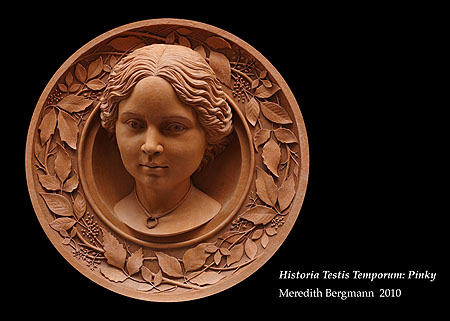Meredith Bergmann

HISTORIA TESTIS TEMPORUM: Pinky
Meredith Bergmann 2010
cast resin
48" x 48" x 18"
Created for a residency at the Brooklyn Historical Society, this pseudo-public artwork was inspired by the giant terracotta portraits of European cultural heroes surrounded by American plants that ornament the Society's 1880 building. The building's iconography pairs Michelangelo with tobacco and Beethoven with blackberries. The Society's archive contains the bill of sale for "Pinky," who in 1860, at nine years old, was the first of a series of pale-skinned female slaves whom the Reverend Henry Ward Beecher "auctioned" to his congregation to buy their freedom. Sally Maria Diggs ("Pinky") is framed by a wreath of poison ivy.

 n 2008 the Brooklyn Historical Society received a grant to commission 10 artists and writers to create works that "responded to the collection." As a sculptor I respond to sculptures, and ever since 1975, when I lived in Brooklyn Heights, I've been fascinated by the series of giant terra cotta heads that ornament the beautifully detailed BHS building. The heads were black with grime in the 70's and very hard to make out, but in 2008 I saw them cleaned and was eager to research and understand their symbolism. This turned out to be preposterous. I learned the heads were made in 1879 by Olin Levy Warner, an accomplished sculptor, whose statue of William Lloyd Garrison was one of the monuments on Commonwealth Avenue in Boston which I had to "respond to" when I made the Boston Women's Memorial. For the Historical Society, Warner was commissioned by a committee to sculpt heads of great European figures who, as far as I can see, were being asked to return from the grave to confer cultural legitimacy on the Society and its building despite having had nothing to do with Brooklyn history. Perhaps to make them more relevant they were portrayed surrounded by plants which grow in America, so you can see Beethoven entangled in blackberries and Michelangelo embedded in tobacco, which feels particularly strained... Gutenberg hung with hops seems easier somehow. n 2008 the Brooklyn Historical Society received a grant to commission 10 artists and writers to create works that "responded to the collection." As a sculptor I respond to sculptures, and ever since 1975, when I lived in Brooklyn Heights, I've been fascinated by the series of giant terra cotta heads that ornament the beautifully detailed BHS building. The heads were black with grime in the 70's and very hard to make out, but in 2008 I saw them cleaned and was eager to research and understand their symbolism. This turned out to be preposterous. I learned the heads were made in 1879 by Olin Levy Warner, an accomplished sculptor, whose statue of William Lloyd Garrison was one of the monuments on Commonwealth Avenue in Boston which I had to "respond to" when I made the Boston Women's Memorial. For the Historical Society, Warner was commissioned by a committee to sculpt heads of great European figures who, as far as I can see, were being asked to return from the grave to confer cultural legitimacy on the Society and its building despite having had nothing to do with Brooklyn history. Perhaps to make them more relevant they were portrayed surrounded by plants which grow in America, so you can see Beethoven entangled in blackberries and Michelangelo embedded in tobacco, which feels particularly strained... Gutenberg hung with hops seems easier somehow.
When I got into the building and looked at the Society's archival materials I was fascinated by the collection of 19th century children's books, with their gorgeous design, high moral tone, unalloyed racism and sentimentality, and by the original materials from Henry Ward Beecher's antislavery campaign. Beecher, who was called "the most famous man in America," filled the 3000-seat Plymouth Church twice on Sundays, and the ferries to Brooklyn were nicknamed "Beecher's Boats." Beecher waffled a bit on abolition before coming out against slavery dramatically, staging mock slave auctions from the pulpit, always of very young, light-skinned, attractive enslaved girls. The congregation went wild and threw money and jewelry into the collection plates to buy their freedom. The first of these auctions was for "Pinky," nine years old and "having only one sixteenth of negro blood, or half an octaroon," according to a local paper. One of the congregants threw a ring into the collection plate and Beecher proclaimed "with this ring I thee wed to Freedom!" As I read the documents and looked at her photos there was much in the story that moved me and much that made me cringe.
Over the past two years I have made a sculpture that explores the way we think about public art. Here is Sally Maria Diggs, known and sold as "Pinky", baptized as Rose Ward Hunt, surrounded by that pervasive, purely American plant, Poison Ivy. Is she ready--are we ready for her--to join Beethoven, Michelangelo, Shakespeare and Gutenberg on the façade? Let's imagine a committee meeting in the 1870's. Warner has come back from Paris, where he went to study sculpture. He survived and wrote a defense of the Paris Commune, and now he proposes "Pinky" as one of the sculptures for the façade, only to have it rejected by the Society as inappropriate. Certainly this is an easier sculpture to get approved today; maybe almost too easy--like Shakespeare with plums was then.

Beethoven with Blackberries and inscription taken from Cicero's De Oratore: Historia Testis Temporum, or History is the witness to Time.
"...with what voice, unless the voice of the orator, can it be passed on into deathlessness?"

Initial design sketch of Pinky with Poison Ivy


|
